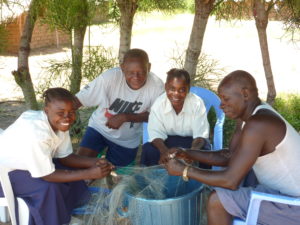Too often we forget that not everyone has access to education, which is one of the UN sustainable development goals. Back in 2018, at an age that many people in Europe think about retirement, our collaborator Mulimbwa N’Sibula from the Centre for Research in Hydrobiology (CRH) at Uvira (DR Congo) finally saw a chance to complete a Masters in Science at the University of Kisangani. In 2021, eager to go on, he registered for PhD studies. Today, 15th of November 2024, at age 75, Mulimbwa successfully defended his PhD thesis “Population dynamics of the Lake Tanganyika sardines Stolothrissa tanganicae and Limnothrissa miodon, and their predator Lates stappersii: implications for sustainable fisheries management in Northern Lake Tanganyika”. The PhD is awarded by the University of Kisangani (DR Congo).



The Centre for Research in Hydrobiology (CRH) where Mulimbwa is employed is located at the Congolese shore of Lake Tanganyika. At CRH, Mulimbwa works as an expert in fisheries biology, fisheries management, the ecology of the two freshwater sardines, their zooplankton prey (especially copepods), their predators, and tropical limnology.
Congratulations Dr. Mulimbwa with this fantastic achievement, and thanks for serving as such a great example of perseverance!
If you think that Mulimbwa is now tired of study and research, you are wrong. In the coming weeks, the new doctor will return to Uvira to work on our project CHIPOLATA. We are looking forward to continue the work with Mulimbwa and the CRH to understand even better how humans and climate change affect the pelagic fish community of Lake Tanganyika.
Below you can find some of Mulimbwa’s publications.
Catch data in relation to prey dynamics:
Mulimbwa N, Raeymaekers JAM & Sarvala J (2014). Seasonal changes in the pelagic catch of two clupeid zooplanktivores in relation to the abundance of copepod zooplankton in the northern end of Lake Tanganyika. Aquatic Ecosystem Health & Management 17, 25-33. https://www.tandfonline.com/doi/full/10.1080/14634988.2014.883896
Reproductive activities:
Mulimbwa N, Sarvala J & Raeymaekers JAM (2014). Reproductive activities of two zooplanktivorous clupeid fish in relation to the seasonal abundance of copepod prey in the northern end of Lake Tanganyika. Belgian Journal of Zoology 144, 77-92. https://belgianjournalofzoology.eu/index.php/BJZ/article/view/68
Mulimbwa N, Milec LJM, Raeymaekers JAM, Sarvala J, Plisnier P-D, Marwa B & Micha J-C (2022). Spatial and seasonal variation in reproductive indices of the clupeids Limnothrissa miodon and Stolothrissa tanganicae in the Congolese waters of northern Lake Tanganyika. Belgian Journal of Zoology 152, 13–31. https://belgianjournalofzoology.eu/BJZ/article/view/96
Growth trajectories:
Mulimbwa N, Gordó-Vilaseca C, Milec LJM, Patel DM, Kankonda BA, Micha J-C, Sarvala J & Raeymaekers JAM (2024). Growth parameters of the clupeids Limnothrissa miodon and Stolothrissa tanganicae in northern Lake Tanganyika. Belgian Journal of Zoology 154: 117–137. https://belgianjournalofzoology.eu/BJZ/article/view/184
Economical impact of fisheries:
Mulimbwa N, Sarvala J, Micha J-C. (2019). The larval fishery on Limnothrissa miodon in the Congolese waters of Lake Tanganyika: Impact on exploitable biomass and the value of the fishery. Fish Management and Ecology 26: 444–450. https://doi.org/10.1111/fme.12309